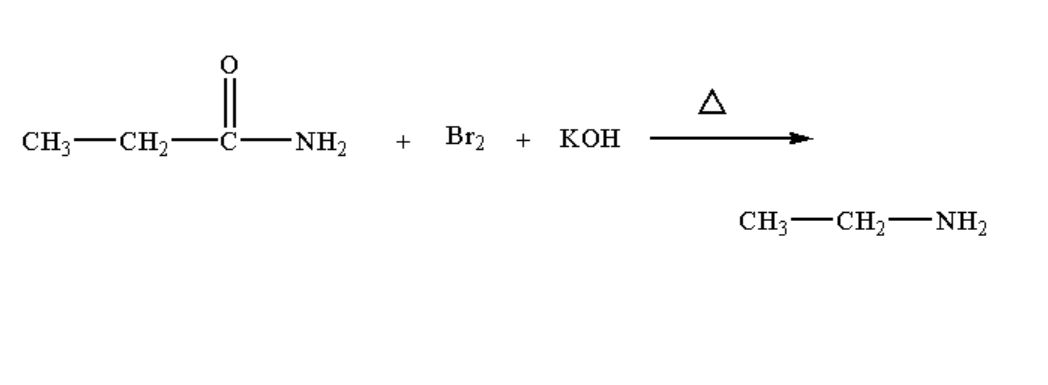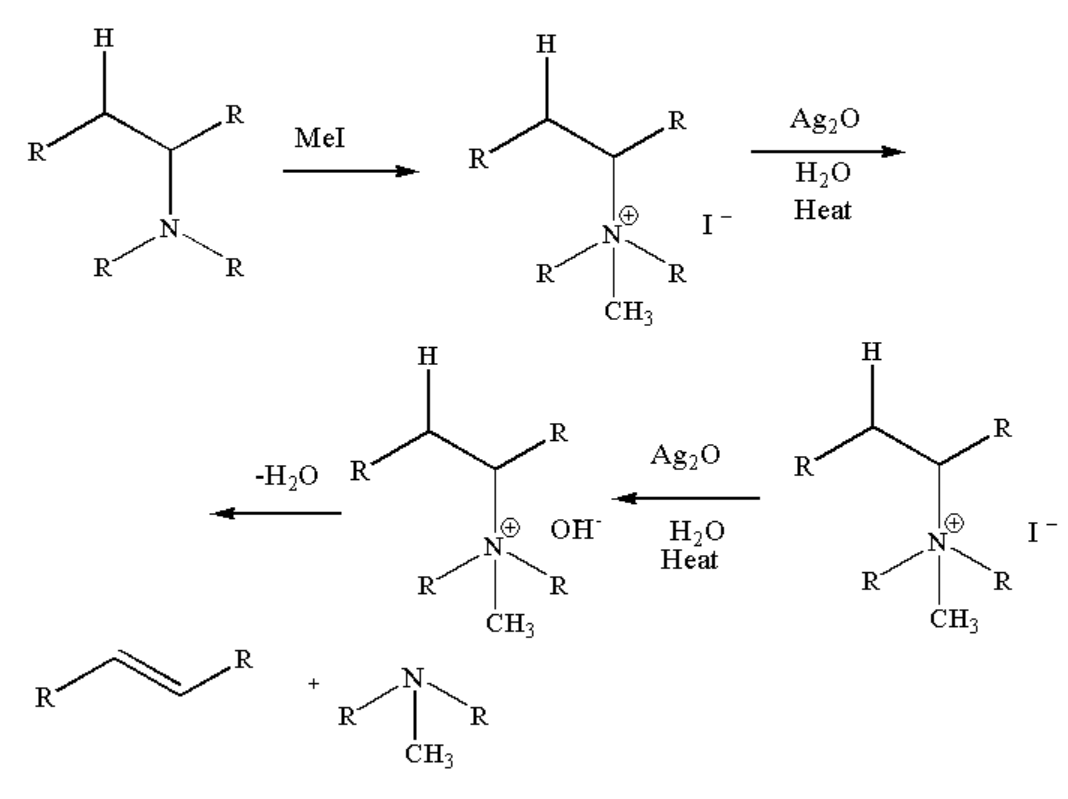
Propionamide on Hofmann degradation gives-
A. Methyl amine
B. Ethyl amine
C. Propyl amine
D. Ethyl cyanide
Answer
224.7k+ views
Hint: Propionamide is an amide compound with general formula \[RCON{H_2}\] . The compound formed has one less carbon atom than the amide.
Complete Step by Step Solution:
Hoffmann degradation reaction is a type of reaction where primary amide is converted to a primary amine. The reaction takes place in presence of a strong base which attacks the amide. The reaction takes place by heating the primary amide using a halogen mixture of chlorine or bromine, a strong base and water.
In this reaction, halogen mainly reacts with sodium hydroxide which forms sodium hypobromite which changes the primary amide into an isocyanate intermediate. Water attacks the isocyanate intermediate causing the proton transfer and resulting in the formation of ammonium cation. Due to the thermal condition, the carbon dioxide explodes and after quenching ammonium cation, a primary amine product is formed.
When propionamide is heated with bromine in presence of potassium hydroxide or when propionamide undergoes Hofmann degradation, the product formed is ethyl amine.
The Hoffman degradation reaction of propionamide is shown below.

Image: Hofmann degradation reaction of propionamide
Therefore, the correct option is B.
Note: Hofmann degradation reaction is also termed as Hoffmann bromamide reaction. There is another term known as Hofmann elimination reaction in which tertiary amines and alkenes are formed as a product by reacting quaternary ammonium with methyl iodide and heating the compound formed with silver oxide and water.
The general reaction is shown below.

Image: Hofmann elimination reaction
Complete Step by Step Solution:
Hoffmann degradation reaction is a type of reaction where primary amide is converted to a primary amine. The reaction takes place in presence of a strong base which attacks the amide. The reaction takes place by heating the primary amide using a halogen mixture of chlorine or bromine, a strong base and water.
In this reaction, halogen mainly reacts with sodium hydroxide which forms sodium hypobromite which changes the primary amide into an isocyanate intermediate. Water attacks the isocyanate intermediate causing the proton transfer and resulting in the formation of ammonium cation. Due to the thermal condition, the carbon dioxide explodes and after quenching ammonium cation, a primary amine product is formed.
When propionamide is heated with bromine in presence of potassium hydroxide or when propionamide undergoes Hofmann degradation, the product formed is ethyl amine.
The Hoffman degradation reaction of propionamide is shown below.

Image: Hofmann degradation reaction of propionamide
Therefore, the correct option is B.
Note: Hofmann degradation reaction is also termed as Hoffmann bromamide reaction. There is another term known as Hofmann elimination reaction in which tertiary amines and alkenes are formed as a product by reacting quaternary ammonium with methyl iodide and heating the compound formed with silver oxide and water.
The general reaction is shown below.

Image: Hofmann elimination reaction
Recently Updated Pages
JEE Main 2025-26 Mock Test: Organic Compounds Containing Nitrogen

JEE Main 2025-26 Organic Compounds Containing Nitrogen Mock Test

JEE Main Chemical Kinetics Mock Test 2025-26: Free Practice Online

JEE Main 2025-26 Organic Compounds Containing Oxygen Mock Test

JEE Main 2025-26 Organic Compounds Containing Halogens Mock Test

Sodium acetate on heating with soda lime produce A class 12 chemistry JEE_Main

Trending doubts
JEE Main 2026: City Intimation Slip and Exam Dates Released, Application Form Closed, Syllabus & Eligibility

JEE Main 2026 Application Login: Direct Link, Registration, Form Fill, and Steps

Understanding the Angle of Deviation in a Prism

How to Convert a Galvanometer into an Ammeter or Voltmeter

Hybridisation in Chemistry – Concept, Types & Applications

Ideal and Non-Ideal Solutions Explained for Class 12 Chemistry

Other Pages
NCERT Solutions For Class 12 Chemistry Chapter 1 Solutions - 2025-26

JEE Advanced Marks vs Ranks 2025: Understanding Category-wise Qualifying Marks and Previous Year Cut-offs

Solutions Class 12 Chemistry Chapter 1 CBSE Notes - 2025-26

NCERT Solutions ForClass 12 Chemistry Chapter Chapter 4 The D and F Block Elements

Biomolecules Class 12 Chemistry Chapter 10 CBSE Notes - 2025-26

NCERT Solutions For Class 12 Chemistry Chapter 10 Biomolecules - 2025-26




